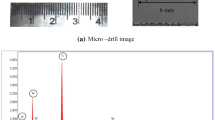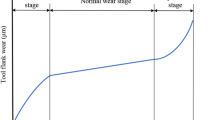Abstract
Undetected tool wear during drilling of woven composites can cause laminate damage and fiber pull-out and fuzzing, causing subsurface damage. This diminishes the life of the produced part under fatigue loads. Thus, the producing of proper and reliable holes in woven composites requires accurate monitoring of the cutting tool wear level to safeguard the machined parts and increase process productivity and profitability. Available tool condition monitoring (TCM) systems mainly require long development lead time and extensive experimental efforts to predict the tool wear within predefined values of cutting conditions. The changes in these values require system relearning. Therefore, developing of a smart generalized TCM system that can accurately predict tool wear based on unlearned data during drilling of woven composite plates is crucial. In this work, an attempt was presented and discussed to predict the tool wear in drilling of woven composite plates at different and wide range of cutting conditions based on the drilling forces using biased learning data. A generalized heuristic model was proposed to accurately predict tool wear value. The performance of the proposed model was benchmarked with respect to four machine learning techniques namely regression tree, support vector machine (SVM), Gaussian process regression (GPR), and artificial neural network (ANN). Extensive experimental validation tests have showed that the GPR model has offered the lowest prediction error based on a reduced biased learning dataset, which represents 50% reduction in learning efforts compared with available literature. However, the developed heuristic model showed a comparable accuracy using significantly less learning efforts.











Similar content being viewed by others
Abbreviations
- VB:
-
Flank tool wear
- CFRP:
-
Carbon fiber–reinforced polymer
- GFRP:
-
Glass fiber–reinforced polymer
- ANFIS:
-
Adaptive network–fuzzy systems
- SVM:
-
Support vector machine
- GPR:
-
Gaussian process regression
- ANN:
-
Artificial neural network
- Fz:
-
Thrust force
- Fc:
-
Cutting force
- ΔFzi :
-
The change in the thrust force at fresh tool (i = 0) and after number of cuts i
- ΔFci :
-
The change in the cutting force at fresh tool (i = 0) and after number of cuts i
- a and b:
-
Trained constants
- a’ and b’:
-
Predicted constants
- WMSE:
-
Weighted mean squared error
- MLP:
-
Multilayer perceptron
- RMSE:
-
Root mean square error
- R 2 :
-
R squared
- MAE:
-
Mean absolute error
References
Vigneshwaran S, Uthayakumar M, Arumugaprabu V (2018) Review on machinability of fiber reinforced polymers: a drilling approach. Silicon 10(5):2295–2305
Krishnaraj V, Zitoune R, Davim JP (2013) Drilling of polymer-matrix composites. Springer
Davim JP Machining composites materials. Wiley
Sheikh-Ahmad (2009) Machining of polymer composites, vol 387355391. Springer
Abrao AM et al (2007) Drilling of fiber reinforced plastics: a review. J Mater Process Technol 186(1-3):1–7
Sadek A, Shi B, Meshreki M, Duquesne J, Attia MH (2015) Prediction and control of drilling-induced damage in fibre-reinforced polymers using a new hybrid force and temperature modelling approach. CIRP Ann 64(1):89–92
Hintze W, Clausen R, Schütte C, Kroll K (2018) Evaluation of the total cutting force in drilling of CFRP: a novel experimental method for the analysis of the cutting mechanism. Prod Eng 12(3-4):431–440
Davim JP, Reis P (2003) Drilling carbon fiber reinforced plastics manufactured by autoclave—experimental and statistical study. Mater Des 24(5):315–324
Geier N, Szalay T (2017) Optimisation of process parameters for the orbital and conventional drilling of uni-directional carbon fibre-reinforced polymers (UD-CFRP). Measurement. 110:319–334
Xu J, An Q, Cai X, Chen M (2013) Drilling machinability evaluation on new developed high-strength T800S/250F CFRP laminates. Int J Precis Eng Manuf 14(10):1687–1696
Anand RS, Patra K, Steiner M (2014) Size effects in micro drilling of carbon fiber reinforced plastic composite. Prod Eng 8(3):301–307
Tsao C (2008) Prediction of thrust force of step drill in drilling composite material by Taguchi method and radial basis function network. Int J Adv Manuf Technol 36(1-2):11–18
Xu J, An Q, Chen M (2014) A comparative evaluation of polycrystalline diamond drills in drilling high-strength T800S/250F CFRP. Compos Struct 117:71–82
Merino-Pérez JL, Royer R, Merson E, Lockwood A, Ayvar-Soberanis S, Marshall MB (2016) Influence of workpiece constituents and cutting speed on the cutting forces developed in the conventional drilling of CFRP composites. Compos Struct 140:621–629
Bhuiyan M, Choudhury I (2014) 13.22—Review of sensor applications in tool condition monitoring in machining. Comprehen Mater Process 13:539–569
Brophy B, Kelly K, Byrne G (2002) AI-based condition monitoring of the drilling process. J Mater Process Technol 124(3):305–310
Azmi A (2015) Monitoring of tool wear using measured machining forces and neuro-fuzzy modelling approaches during machining of GFRP composites. Adv Eng Softw 82:53–64
Slamani M, Chatelain JF, Hamedanianpour H (2015) Comparison of two models for predicting tool wear and cutting force components during high speed trimming of CFRP. Int J Mater Form 8(2):305–316
Patra K, Jha AK, Szalay T, Ranjan J, Monostori L (2017) Artificial neural network based tool condition monitoring in micro mechanical peck drilling using thrust force signals. Precis Eng 48:279–291
Caggiano A, Rimpault X, Teti R, Balazinski M, Chatelain JF, Nele L (2018) Machine learning approach based on fractal analysis for optimal tool life exploitation in CFRP composite drilling for aeronautical assembly. CIRP Ann 67(1):483–486
Hassan M, Damir A, Attia H, Thomson V (2018) Benchmarking of pattern recognition techniques for online tool wear detection. Procedia CIRP 72:1451–1456
Loh WY, Shih YS (1997) Split selection methods for classification trees. Stat Sin:815–840
Qu J, Zuo MJ (2010) Support vector machine based data processing algorithm for wear degree classification of slurry pump systems. Measurement 43(6):781–791
Rasmussen CE (2003) Gaussian processes in machine learning. In: Summer School on Machine Learning. Springer
Işık B, Ekici E (2010) Experimental investigations of damage analysis in drilling of woven glass fiber-reinforced plastic composites. Int J Adv Manuf Technol 49(9-12):861–869
Xu J, Li C, Chen, El Mansori M, Ren F (2019) An investigation of drilling high-strength CFRP composites using specialized drills. Int J Adv Manuf Technol 103(9-12):3425–3442
Author information
Authors and Affiliations
Corresponding author
Additional information
Publisher’s note
Springer Nature remains neutral with regard to jurisdictional claims in published maps and institutional affiliations.
Appendix
Appendix
Rights and permissions
About this article
Cite this article
Hegab, H., Hassan, M., Rawat, S. et al. A smart tool wear prediction model in drilling of woven composites. Int J Adv Manuf Technol 110, 2881–2892 (2020). https://doi.org/10.1007/s00170-020-06049-4
Received:
Accepted:
Published:
Issue Date:
DOI: https://doi.org/10.1007/s00170-020-06049-4




